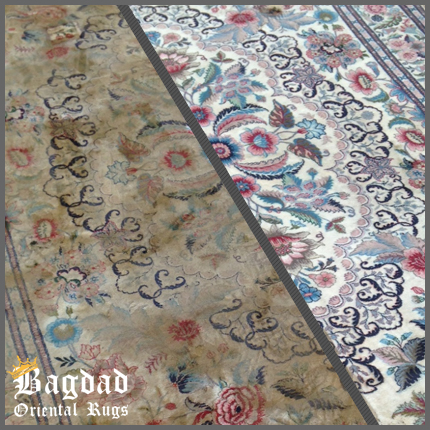If you live in Houston, heavy rain and flooding is a fact of life. Many long-time Houstonians are used to the inclement weather and know how to take it in stride. It only becomes an issue when storm damage results in bulging walls, distorted floors and discolored area rugs. For those with expensive antique or heirloom rugs, the effects of water damage can be especially devastating. You spend years carefully caring for your rug only to have flooding wash all this hard work away in an instant.
When a rug is drenched in water, it often results in mold and mildew accumulation, the bleeding of rug dyes and a pervasive smell that’s not at all pleasant to experience in person.
Fortunately, Houston rug restoration companies such as Bagdad Oriental Rugs are experienced in reviving rugs and reversing water damage to them. It’s especially important that your rug be handled by an experienced, professional rug restoration specialist so that any present damage isn’t made worse with faulty techniques and equipment.
With that in mind, let’s review the key steps in the rug restoration process…

Step 1. Damage Assessment
A rug repair artist carefully and thoroughly examines the water damaged rug in order to determine what can be done to restore it to its pre-flood state. Depending on the fibers your rug is made of, the length of time in which it’s been wet, and the type of water that saturated it, the rug repairer will figure out what steps need to be taken. The repairer will also check for biological contaminants and other microorganisms so that the long-term health of yourself and your family isn’t compromised.
Step 2. Fringe Treatment
It may be necessary to replace and remove fringes should water damage to them prove particularly extreme. Making sure that rug fringes are taken care of is particularly important because the care taken to treat them reflects on the overall state of your rug. Most reputable rug restorers offer fringe replacement and removal services that improve your rug’s look. Fringe extensions are also another viable option in cases where the pre-existing fringes cannot be salvaged due to excessive water damage.
Step 3. Rug Cleaning
Why should rugs that are wet due to flooding be washed? The reason for this is that professional rug washing services rids the rug of ruinous bacteria and dirt, thereby making it as clean and fresh as new. Oftentimes the rug “washing” process encompasses dry cleaning techniques that removes excess water and grime while treating the rug. Learn more about our rug cleaning process here.
Step 4. Deep Shampooing and Rinsing
A necessary component of thorough rug cleaning and washing is the process of applying chemical and enzyme free shampoos. Such shampoos, when applied with a soft bristle brush machine, works to rid the rug of any deep-set dirt that the rug absorbed during flooding. What’s more, rinsing the rug in warm water breaks up any residual particulates inside the rug before it’s hung out to dry in a specialized heating chamber.
Step 5. Re-dyeing and Restoring Colors
Once the rug has been thoroughly cleaned and dried, there’s still the matter of restoring the colors that bled or faded away. Experienced color technicians strive to remove stains caused by water damage as well as re-dye colors to be a match for the original. With this step in the process complete, you should be able to enjoy a restored area rug that shows little, if any, symptoms of previous damage.
Of course, it should be noted that no two rugs or damage situations are exactly alike. If you have a water-damaged rug, we advise you scheduling an in-store consultation so we can assess what steps we need to take to bring your rug to its former luster!

